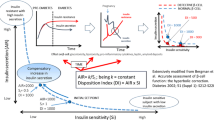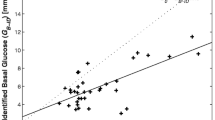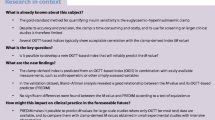Abstract
Several methods have been proposed for evaluating a person’s insulin sensitivity from an oral glucose tolerance test (OGTT) and the euglycemic insulin clamp technique. However, none are easy or inexpensive to implement since the plasma insulin concentration, a key variable for assessing the insulin sensitivity index (ISI), is required to be clinically measured at specific times. Therefore, the purpose of this study is to develop a new ISI that can be easily and accurately obtained by patients themselves without costly, time-consuming, and inconvenient testing methods. This study proposes a simple self-administered testing method, simulated on a computerized model of type II diabetic patients, for estimating the ISI. The test involves a 75-g glucose ingestion and two injections of 10 mU/kg insulin. Blood glucose is measured 1 and 2 h later. The test was evaluated by using a previously developed diabetic-patient dynamic model. Fifteen sets of OGTT data from diabetic patients published in the literature were used for the model development. A simulation of the proposed self-administered test indicates that the proposed ISI correlates well with the ISI called M-value obtained from the gold standard but elaborate euglycemic hyperinsulinemic clamp (r = 0.927, p = 0.0045). The proposed ISI is considered to be easy to perform, time-saving, inexpensive, and accurate enough for clinical assessments.





Similar content being viewed by others
References
Weir, G., & Bonner-Weir, S. (2004). Five stages of evolving β-cell dysfunction during progression to diabetes. Diabetes, 53, S16–S21.
DeFronzo, R. (1988). The triumvirate: Beta-cell, muscle, liver. A collusion responsible for NIDDM. Diabetes, 37, 667–687.
Reaven, G. M., Lithell, H., & Landsberg, L. (1996). Hypertension and associated metabolic abnormalities—The role of insulin resistance and the sympathoadrenal system. New England Journal of Medicine, 334, 374–381.
Katz, A., Nambi, S., & Mather, K. (2000). Quantitative insulin sensitivity check index: A simple, accurate method for assessing insulin sensitivity in humans. Journal of Clinical Endocrinology and Metabolism, 85, 2402–2410.
Bergman, R. N. (1979). Quantitative estimation of insulin sensitivity. American Physiological Society, 236, E667–E677.
DeFronzo, R. (1979). Glucose clamp technique: A method for quantifying insulin secretion and resistance. American Journal of Physiology—Endocrinology and Metabolism, 237, 214–223.
Steil, G. M., Volund, A., Kahn, S. E., & Bergman, R. N. (1993). Reduced sample number for calculation of insulin sensitivity and glucose effectiveness from the minimal model. Suitability for use in population studies. Diabetes, 42, 250–256.
Yang, Y. J., Youn, J. H., & Bergman, R. N. (1987). Modified protocols improve insulin sensitivity estimation using the minimal model. American Journal of Physiology, 253, E595–E602.
Matthews, D., Hosker, J., Rudenski, A., Naylor, B., Treacher, D., & Turner, R. (1985). Homeostasis model assessment: insulin resistance and beta-cell function from fasting plasma glucose and insulin concentrations in man. Diabetologia, 28, 412–419.
Laakso, M. (1993). How good a marker is insulin level for insulin resistance? American Journal of Epidemiology, 137, 959–965.
Legro, R. S., Finegood, D., & Dunaif, A. (1998). A fasting glucose to insulin ratio is a useful measure of insulin sensitivity in women with polycystic ovary syndrome. Journal of Clinical Endocrinology and Metabolism, 83, 2694–2698.
Davey, R. X. (2002). Birthweight and risk for diabetes. Diabetes Care, 25, 1886–1902.
Cederholm, J., & Wibell, L. (1990). Insulin release and peripheral sensitivity at the oral glucose tolerance test. Diabetes Research and Clinical Practice, 10, 167–175.
Matsuda, M., & DeFronzo, R. (1999). Insulin sensitivity indices obtained from oral glucose tolerance testing comparison with the euglycemic insulin clamp. Diabetes Care, 22, 1462–1470.
Stumvoll, M., Mitrakou, A., Pimenta, W., Jenssen, T., Yki-Järvinen, H., Van Haeften, T., et al. (2000). Use of the oral glucose tolerance test to assess insulin release and insulin sensitivity. Diabetes Care, 23, 295–301.
Gutt, M., Davis, C. L., Spitzer, S. B., Llabre, M. M., Kumar, M., Czarnecki, E. M., et al. (2000). Validation of the insulin sensitivity index (ISI(0,120)): Comparison with other measures. Diabetes Research and Clinical Practice, 47, 177–184.
Vahidi, O. (2013). Dynamic modeling of glucose metabolism for the assessment of type II diabetes mellitus. Ph.D. Thesis, The University of British Columbia, 2013.
Vahidi, O., Kwok, K. E., Gopaluni, R. B., & Sun, L. (2011). Developing a physiological model for type II diabetes mellitus. Biochemical Engineering Journal, 55, 7–16.
Guyton, J. R., Foster, R. O., Soeldner, J. S., Tan, M. H., Kahn, C. B., Koncz, L., & Gleason, R. E. (1978). A model of glucose-insulin homeostasis in man that incorporates the heterogeneous fast pool theory of pancreatic insulin release. Diabetes, 27, 1027–1042.
Sorensen, J. T. (1985). A physiological model of glucose metabolism in man and its use to design and assess improved insulin therapies for diabetes. Ph.D. Thesis, Massachusetts Institute of Technology, 1985.
Vahidi, O., Gopaluni, R., & Kwok, E. (2011). Detection of organ dysfunction in type II diabetic patients. In American Control Conference, vol 3, pp. 4769–4774
Vahidi, O., Kwok, E., Gopaluni, R. B. & Sun, L. (2010). Development of a physiological model for patients with type 2 diabetes mellitus. In American Control Conference, pp. 2027–2032
Barazandegan, M., Ekram, F., Kwok, E., Gopaluni, B., & Tulsyan, A. (2015). Assessment of type II diabetes mellitus using irregularly sampled measurements with missing data. Bioprocess and Biosystems Engineering, 38, 615–629.
Ekoé, J.-M., Punthakee, Z., Ransom, T., Prebtani, A. P. H., & Goldenberg, R. (2013). Screening for type 1 and type 2 Diabetes. Canadian Journal of Diabetes, 37, S12–S15.
Hayashi, T., Boyko, E. J., Sato, K. K., McNeely, M. J., Leonetti, D. L., Kahn, S. E., & Fujimoto, W. Y. (2013). Patterns of insulin concentration during the OGTT predict the risk of type 2 diabetes in Japanese Americans. Diabetes Care, 36, 1229–1235.
Bakari, A., & Onyemelukwe, G. (2004). Plasma insulin response to oral glucose tolerance test in type-2 Nigerian diabetics. East African Medical Journal, 81, 463–467.
Jarrett, R., Baker, I., Keen, H., & Oakley, N. (1972). Diurnal variation in oral glucose tolerance: Blood sugar and plasma insulin levels morning, afternoon, and evening. British Medical Journal, 1, 199–201.
Knop, F. K., Vilsbøll, T., Madsbad, S., Holst, J. J., & Krarup, T. (2007). Inappropriate suppression of glucagon during OGTT but not during isoglycaemic i.v. glucose infusion contributes to the reduced incretin effect in type 2 diabetes mellitus. Diabetologia, 50, 797–805.
Knop, F. K., Vilsbøll, T., Højberg, P. V., Larsen, S., Madsbad, S., Vølund, A., et al. (2007). Reduced incretin effect in type 2 diabetes: Cause or consequence of the diabetic state? Diabetes, 56, 1951–1959.
Chisholm, D., Young, J., & Lazarus, L. (1969). The gastrointestinal stimulus to insulin release: I. Secretin. Journal of Clinical Investigation, 48, 1453–1460.
Ekram, F., Barazandegan, M., Kwok, E. & Gopaluni, B. (2015). Evaluation of treatment regimens for blood glucose regulation in type II diabetes using pharmacokinetic-pharmacodynamic modeling. In Proceedings of 34th Chinese control conference (pp. 8519–8524).
Acknowledgments
We would like to thank Dr. Omid Vahidi for his suggestions and support.
Author information
Authors and Affiliations
Corresponding author
Rights and permissions
About this article
Cite this article
Barazandegan, M., Ekram, F., Kwok, E. et al. Simple Self-Administered Method for Assessing Insulin Sensitivity in Diabetic Patients. J. Med. Biol. Eng. 36, 197–205 (2016). https://doi.org/10.1007/s40846-016-0122-3
Received:
Accepted:
Published:
Issue Date:
DOI: https://doi.org/10.1007/s40846-016-0122-3




